I eat yogurt nearly every morning. Along with my tea, it’s been a ritual that I’ve had for nearly 20 years. Back before my diagnosis of celiac disease in 1999 and prior to my interest in real food, I used to stick everything imaginable in it and more times than not, I wasn’t doing myself any favors in terms of sugar consumption. I also made the mistake of eating non-fat yogurt as that was what I believed to be the best choice. My how things have changed. Most of the time, I eat full fat Greek yogurt with something as simple as blueberries — I could probably live on this if I had to, it’s that good. Beyond the berries, I’ll sometimes make my own granola out of nuts and seeds and a little bit of raw honey and add that as well. The possibilities are endless.
I just came across this post from Jenny of Nourished Kitchen and needless to say, I was intrigued. As much as I like yogurt, seeing these traditional Scandinavian recipes that vary in consistency has me intrigued. I’ve tried her homemade root beer and it was nothing short of delicious as well as a number of her other recipes. The love and care that she puts into these recipes is admirable and so so obvious — you’d do really well with any of them.
– – –

“Viili, piimä, filmjölk, skyr – all obscure mouthfuls of rolling foreign vowels – that mean but one thing: cultured milk. The Scandinavians, whose ill-tempered northern climate necessitates creative application of food preservation techniques, celebrate soured milks and cultured dairy foods in a manner unparalleled by even the yogurt-loving people of the Caucasus. Indeed, they thrive on all manner of cultured and soured milks which are deeply ingrained into their culinary tradition and heritage, and from their undying love for wholesome, naturally soured milks we can all learn a lesson.
Scandinavia, though offering a remarkable plethora of cold-weathered vegetables, berries and other nourishing, suffers from severe, cold and dark winters characteristic of the north. No other word but harsh seems to better describe the challenges of a Scandinavian winter. Indeed, it ought to for the word harsh itself is of Scandinavian origin, coming to the English language from the Norwegian word harsh…”







